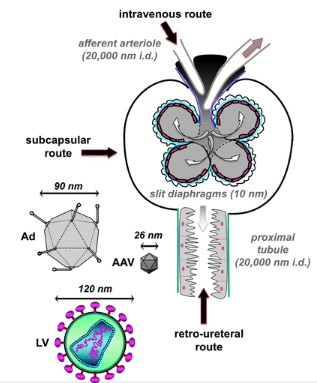As gene therapy is going to be the norm in this new decade to treat renal diseases, delivery of therapeutic genes to the kidney must precede and become more efficient. Renowned Mayo clinic has taken a positive step in this direction using a novel approach in which three different gene delivery vectors were injected intravenously and directly into the kidneys of mice successfully.
In an article published in Human Gene Therapy, Jeffrey Rubin, Tien Nguyen, Kari Allen, Katayoun Ayasoufi, and Michael Barry of the Mayo Clinic wrote about the comparison of gene delivery to the kidney by adenovirus, adeno-associated virus and lentiviral vectors after intravenous and direct kidney injections.

As the kidney filters out large compounds from the bloodstream, the researchers focused on the ability to deliver three different sized vectors via an intravenous route -- small adeno-associated virus (AAV) vectors (25 nm), larger adenovirus vectors (100 nm) and lentiviral vectors (120 nm).
"When vectors were delivered by the intravenous (IV) route in mice, weak luciferase activity was observed in the kidney with substantially more in the liver. When gene delivery was observed in the kidney, expression was primarily in the glomerulus. To avoid these limitations, vectors were injected directly into the kidney by retrograde ureteral (RU) and subcapsular (SC) injections in mice," observed authors in their abstract version of the paper.
To bypass the filtering mechanism of the kidney, they also tested two different direct injection routes into the kidney and found these to be superior to intravenous injections. However, some of the vectors were able to leak out of the kidney, creating the possibility for off-target tissue effects, noted the writers.
The data demonstrated the utility of direct kidney injections to circumvent the kidney size exclusion barrier and also identify the effects of vector size on on-target and off-target transduction, thus laying the foundation for the use of different vector platforms for gene therapy of diverse kidney diseases, said researchers.

The potential for direct injections opens new possibilities for treating kidney diseases with gene therapy, but additional improvements are needed, said the researchers. "The great burden of kidney diseases in the U.S .and Europe has yet to be impacted by gene therapy," says Editor-in-Chief Terence R. Flotte of the journal Human Gene Therapy and also Professor of the University of Massachusetts Medical School.
"The Mayo Clinic team has performed an important head-to-head comparison of currently available gene therapy technology, to identify which may best be used to address this im-portant group of diseases," added Flotte.









